THOMASON TYPE CORKSCREWS WITH DECORATIVE GOTHIC WINDOWS OR HARVEST BARRELS
Brian May, Nick Hunt and Steven Webb
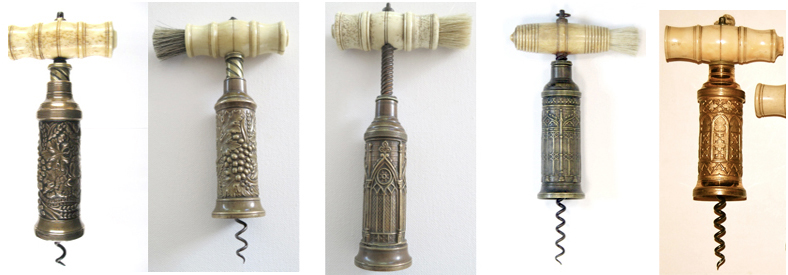
Thomason type corkscrews with fully decorative barrels are very desirable and fall into two groups. The first group has a gothic windows design and are referred to as “gothic windows” or sometimes “cathedral windows”. The second group has a barrel decorated with ears of barley and leaves; grapes and vine leaves; hops cones and leaves, and pears and leaves and are often referred to as “harvest“ or “autumnal fruits”. In British Corkscrew Patents from 1795, Fletcher Wallis refers to these as a Thomason VI church window and a Thomason VIII vines and fruit.
The gothic revival period began in England around 1830, gaining momentum and lasting until around 1900. Gothic architecture became popular once again and particularly for churches with their gothic windows. It seems safe to assume that the gothic window corkscrews were made sometime between 1830 and the late 19th century.
The gothic revival period was also a time of reawakening of Anglo-Catholic beliefs in the face of growing non-conformist beliefs. The images on the harvest barrel corkscrew are all, except the hops cones and vines, symbolic of the Christian faith. Or perhaps the images on the barrel simply depict the components of wine, beer and ale and are thus appropriate for a corkscrew. There is evidence that the harvest corkscrew was made around 1835 (see later).
In keeping with this period, no features typical of an early Thomason corkscrew have been noted on these decorative corkscrews (eg a square plate rivet in the handle).
The gothic windows and harvest decorations have not been reported for narrow or wide rack King’s Screw corkscrews that were also popular at the time.
Production of the corkscrews
We have not located precise details of the manufacture of these corkscrews. Such procedures were not likely to have been published by firms making them. The decorative barrels were generally made from stamped sheets of brass. The following is likely to have occurred. A steel block was first softened and the desired pattern traced on to the flat surface. Next a very skilled engraver generated the pattern intaglio, using chisels and gravers and other tools. Any inscription was introduced with letter punches. The generated die was then hardened. A brass sheet was impressed (or stamped) with the die in a hand driven or a pneumatic press. Finally the brass sheet was trimmed made more malleable by heating, and wrapped to form the barrel. The vertical join was then soldered and these are visible in the final corkscrew.
Gothic windows barrel
A survey of ICCA and Christie’s auctions indicates that for gothic windows, the most common pattern by far is the one shown below. There are six birds, possibly peacocks, resting on the top of the window. This can be seen in more detail in the third image below.
Sometimes the repeating top circumferential pattern is absent (compare the two corkscrews below that have identical barrel patterns).
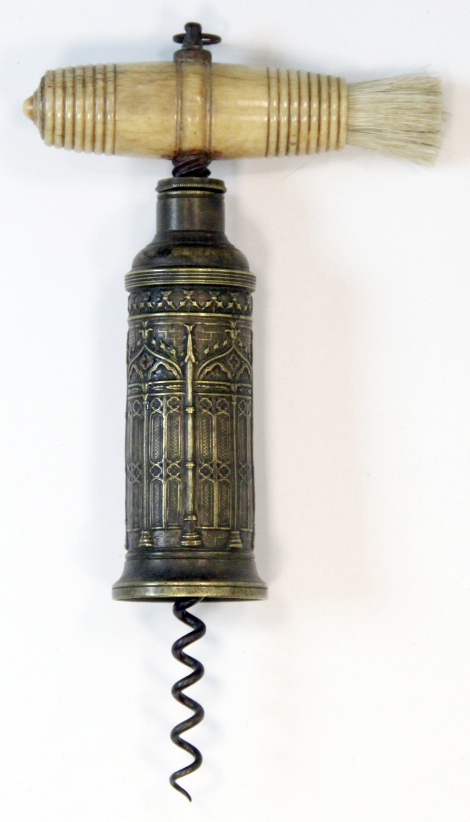
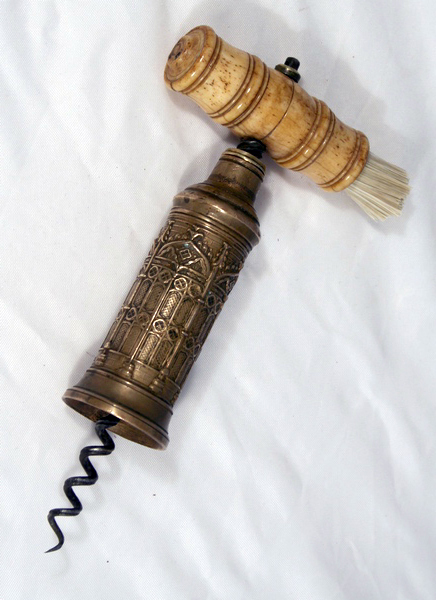
Below is a detailed image of the most common gothic windows with six peacocks on the window top (three on each side).
.jpg)
The second pattern located for gothic window corkscrews is shown below, although it is much less common. We have not identified any variants of this pattern.
.jpg)
The third pattern located for a gothic windows corkscrew is shown below; it appears to be rare. Images of two corkscrews are shown. The stunning barrel on the right has a fire-gilded gold finish; see Steven’s recent blog on www.corkscrewappraisals.com/.
.jpg)
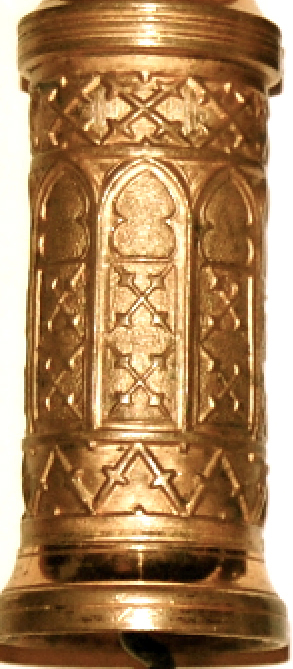
There are no known examples of the gothic windows corkscrew being marked with the manufacturer’s name. Worms were nearly always tapered wire.
Harvest Barrel
Examples of the harvest Thomason type corkscrew are shown below. While the first image shows an uncommon silver plated barrel, other barrels are of brass with different colours reflecting the alloy composition and their patina. The tops of the barrels had various decorations while the worms are plain tapered wire.
Close examination of all images (about 25) indicated that the stamped pattern on all harvest corkscrews was identical. Some small differences could be due to imperfections in the final stamping process or to wear from usage.
.jpg)
It is possible that one manufacturer made the gothic barrel corkscrews (with different dies) and also the harvest barrel corkscrews (the same die).
Could this have been Richard Timmins & Sons as outlined in a following article?
Osborne & Co harvest corkscrew
The greatly prized corkscrew with “OSBORNE & Co IMPROVED PATENT” on the barrel is the only known example of a marked harvest barrel. In the next article, evidence is presented that Osborne & Co was only in existence from about 1835 to 1839.
Interestingly, first impression suggests the pattern on the Osborne corkscrew is the same as that for all other unmarked harvest corkscrews as above. It is marked immediately above the two heads of wheat at the bottom of the barrel and replaces the two horizontal long folding leaves (compare images below with an unmarked example on the left).
.jpg)
However, close examination reveals that the Osborne corkscrew has a slightly different pattern. It differs in the detail: for example veins are clearly visible in the leaves of the unmarked corkscrew shown on the right compared with the Osborne on the left below.
But more significantly there are more grapes on the Osborne marked corkscrew barrel on the left compared with the unmarked on the right.
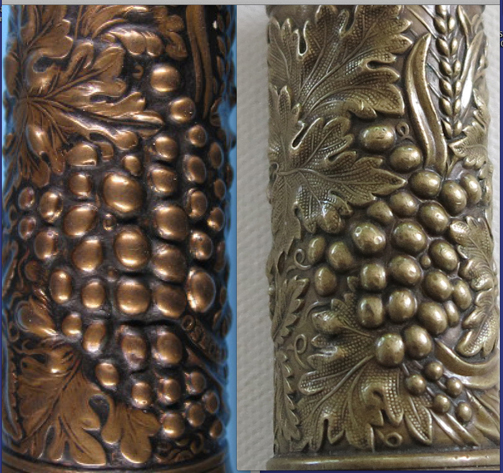
Hence the Osborne corkscrew has been made from a different die and has a slightly different decorative pattern. This raises the possibility that Osborne & Co may have employed the same manufacturer who made the unmarked harvest barrel corkscrews (eg Richard Timmins & Sons).
These questions will be examined in upcoming articles.
Henshall
Finally a rare Henshall type corkscrew with a decorated bronze sleeve was sold at an ICCA auction last year (see image below). The bronze sleeve covered the shaft. However the pattern of grapes and vine leaves etc was completely different from that found on the Thomason type corkscrews described here.
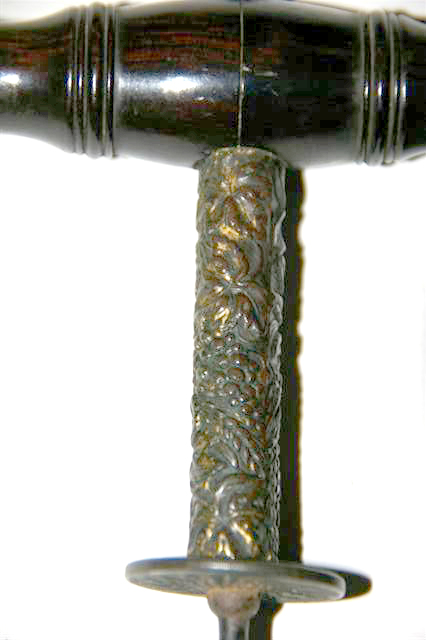
Acknowledgements: We are most appreciative of the images and information from Fletcher Wallis. We wish to thank collectors who kindly sent images of their gothic windows and harvest barrel corkscrews. Thanks also to Vaughan Cottle in Adelaide for discussions on die manufacturing.

